Why this resume works
- Quantifies accomplishments: By showing quantified accomplishments like managing $5M+ projects and boosting efficiency by 30%, the applicant paints a picture of substantial impact.
- Highlights industry-specific skills: With skills in construction safety, task scheduling, and resource allocation, the applicant highlights their robust industry-specific expertise tailored for demanding roles in project management.
- Uses action-oriented language: Action verbs like “managed,” “led,” and “scheduled” powerfully convey initiative and effectiveness.
More Construction Manager Resume Examples
Check out our construction manager resume examples to learn how to showcase your project management skills, leadership experience, and expertise in building processes. Use these samples to help you create a resume that stands out in the construction industry.
Entry-level construction manager
Why this resume works
- Effective use of keywords: By weaving important keywords like “managing budgets” and “top-notch safety and compliance,” the applicant ensures their resume sails smoothly through ATS filters.
- Centers on academic background: The education section prominently features their higher education degrees, showcasing that they have a solid knowledge foundation important for establishing expertise early in one’s career.
- Sections are well-organized: Effective use of bullet points and headers makes the resume easy to scan, ensuring key achievements are quickly accessible and improving readability.
Mid-level construction manager
Why this resume works
- Includes a mix of soft and hard skills: The applicant lists technical skills like project management and budgeting alongside interpersonal skills, showing how they can lead a team and communicate effectively with stakeholders across various projects.
- Displays technical expertise: With certifications like Project Management Professional and Certified Construction Manager, the applicant shows robust technical expertise essential for overseeing complex construction projects efficiently.
- Demonstrates language abilities: Fluency in Spanish, along with French and German skill, showcases versatile language skills that facilitate cross-cultural communication in culturally diverse teams.
Experienced construction manager
Why this resume works
- Focuses on work history: Using a chronological resume, the applicant organizes an extensive work history to showcase progressive career growth and impactful contributions over time.
- Lists relevant certifications: By listing certifications like Certified Construction Manager and LEED Green Associate, the applicant demonstrates mastery in construction management and sustainability.
- Places contact information prominently: A professional resume header is essential for callbacks, providing quick access to contact information and establishing credibility right from the start.
Construction Manager Resume Template (Text Version)
Tao Wang
Columbus, OH 43207
(555)555-5555
Tao.Wang@example.com
Professional Summary
Expert Construction Manager, adept at overseeing multimillion-dollar projects with precision. Proven track record in team leadership and safety optimization, boosting efficiency by 30%.
Work History
Construction Manager
Skyscraper Builders Inc. – Columbus, OH
January 2023 – June 2025
- Managed projects with M+ budgets
- Improved efficiency by 30%
- Led a team of 15 for complex builds
Project Supervisor
Urban Developments Co. – Cleveland, OH
January 2020 – December 2022
- Reduced project costs by 20%
- Oversaw safety compliance
- Scheduled all site operations
Site Foreman
Cityscape Construction – Columbus, OH
January 2018 – December 2019
- Directed crew of 10 workers
- Enhanced site productivity 25%
- Ensured timely project delivery
Skills
- Project Management
- Budget Oversight
- Team Leadership
- Construction Safety
- Resource Allocation
- Task Scheduling
- Quality Assurance
- Strategic Planning
Education
Master’s Degree Construction Management
Harvard University Cambridge, MA
May 2017
Bachelor’s Degree Civil Engineering
University of Pennsylvania Philadelphia, PA
May 2015
Certifications
- Certified Construction Manager – Construction Management Association of America
- LEED Accredited Professional – U.S. Green Building Council
Languages
- Spanish – Beginner (A1)
- French – Beginner (A1)
- German – Beginner (A1)
Related Resume Guides
Advice for Writing Your Construction Manager Resume
Discover how to write a resume that highlights your project management skills, leadership qualities, and hands-on experience in the construction field. Whether you’re managing teams or overseeing large-scale projects, we’ll help you stand out from the crowd.
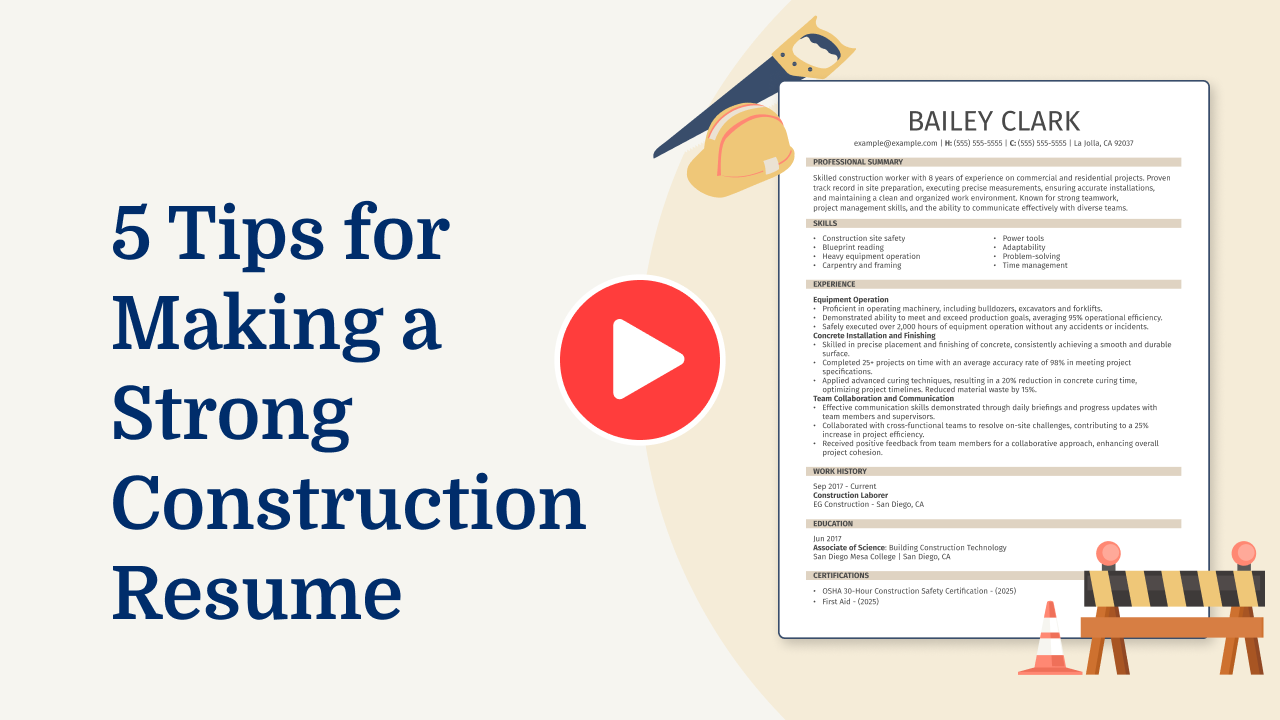
Highlight relevant technical skills
In the role of a construction manager, technical skills are key to ensuring projects are completed safely and efficiently. Create a dedicated technical skills section in your resume or weave them into your work experience descriptions to help employers quickly see your abilities.
A strong focus on relevant skills shows that you’re ready to handle complex tasks and manage teams effectively. Some important technical skills for a construction manager include:
- Project management
- Understanding blueprints and plans
- Knowledge of building codes and regulations
- Cost estimation
- Scheduling and time management
- Familiarity with software tools like AutoCAD, Microsoft Project, or BIM
When listing your technical skills, be specific about what you know how to do. Instead of just saying “project management,” mention any software or methods you’ve used successfully.
This makes your resume stand out and shows that you have practical experience in dealing with real-world challenges on construction sites.
Example of a technical skills section
- Project management software (primavera, microsoft project)
- Construction scheduling and planning
- Budgeting and cost estimation
- Building information modeling (BIM)
- Autocad & revit for design and drafting
- Osha safety standards and compliance
- Contract administration and negotiation
- Quality control and assurance in construction
- Risk management in construction projects
Soft skills matter too! Show off how you work well with others, solve problems, and adapt to change—these are just as key as technical skills.
Quantify your accomplishments
Quantifying your accomplishments as a construction manager makes your resume stand out by showing the real impact of your work. Instead of just listing tasks, focus on what you achieved and back it up with numbers.
For example, instead of saying “managed construction projects,” say “led $5M project that was completed 10% under budget and two weeks ahead of schedule.” This approach helps hiring managers quickly see how you’ve added value in past roles.
In the work experience section, each entry should clearly include your job title, employer name, location, and employment dates. Then, turn job duties into measurable achievements. Highlight results like cost reductions, time saved, or improved efficiency.
For instance, describe how you implemented strategies that reduced material waste by 15% or supervised teams to complete a project 20% faster than planned. Using action verbs along with metrics creates a results-driven resume that shows you’re capable of delivering real outcomes.
Quantified accomplishments make it easier for employers to assess both your skills and the positive impact you can bring to their organization. This method not only demonstrates expertise but also sets you apart from others who may simply list responsibilities without evidence of success.
5 construction manager work history bullet point examples
- Led a team of 15 construction workers to successfully complete a commercial building project 10% ahead of schedule, saving $100K in labor costs.
- Implemented sustainable building practices that reduced carbon footprint by 25% and increased energy efficiency by 40%.
- Managed project budgets over $10 million, consistently achieving cost savings through strategic vendor negotiations.
- Oversaw the safety protocols across multiple sites, resulting in a 50% reduction in workplace incidents over two years.
- Coordinated with architects and engineers to streamline project timelines, cutting construction delays by 30%.
Need help getting started on your resume? Check out our professional resume examples to see how others list their skills and jobs.
Write a powerful professional summary
A professional summary is a short introduction on your resume that tells hiring managers who you are and what you’ve done. It helps them see if you’re the right fit for their needs. Depending on your experience and career level, you must choose between a summary or a resume objective to start.
A professional summary consists of three to four sentences showcasing your experience, skills, and achievements. It’s best for experienced applicants who want to highlight their career accomplishments quickly.
On the other hand, resume objectives are statements about your career goals. They’re ideal for entry-level applicants, people changing careers, or those with employment gaps. While summaries focus on “what I’ve accomplished,” objectives emphasize “what I aim to contribute.”
Now, let’s look at examples of both summaries and objectives tailored for various experience levels. You’ll learn how each can be effectively crafted depending on your background and career stage.
Construction manager resume summary examples
Entry-level
Recent graduate with a Bachelor of Science in Construction Management from a top-tier university. Familiar with project scheduling, cost estimation, and site safety regulations. Certified in OSHA 30-hour Construction Safety and Health. Eager to apply foundational skills in project coordination and support senior managers in delivering high-quality construction projects.
Mid-career
Construction manager with over seven years of experience managing residential and commercial projects. Proficient in budget management, subcontractor coordination, and ensuring compliance with building codes. Known for successful completion of multimillion-dollar projects on time and within budget. Holds PMP certification and excels in team leadership and problem-solving.
Experienced
Seasoned construction manager specializing in large-scale infrastructure development with over 15 years of industry expertise. Demonstrated success in leading diverse teams, optimizing workflows, and implementing advanced project management methodologies. Certified LEED AP with a strong track record of improving sustainability practices on-site. Committed to driving project excellence through strategic planning and innovative solutions.
Construction manager resume objective examples
Recent graduate
Detail-oriented recent construction management graduate with a strong understanding of project planning and execution, seeking an entry-level construction manager role. Eager to apply academic knowledge and internship experience in overseeing projects, ensuring safety compliance, and fostering collaboration among teams.
Career changer
Dedicated professional transitioning from logistics coordination to construction management, bringing expertise in workflow optimization and team leadership. Aspiring to contribute effectively to project timelines and resource management while developing skills in site supervision and quality assurance.
Specialized training
Individual with specialized training in sustainable building practices looking for an opportunity as a construction manager. Committed to integrating eco-friendly solutions into project designs while collaborating with architects and engineers to achieve environmental goals within budget constraints.
Choose a resume template that’s straightforward and readable. Opt for bold headings with simple fonts, avoiding intricate designs that could obscure your skills or experience.
Showcase your credentials
Listing your credentials like certifications, licenses, and special training is really important for a construction manager. In technical fields, these show that you have the right skills and knowledge.
Employers look for these to make sure you can handle the job well. Creating a dedicated certifications section on your resume lets you highlight these achievements clearly. It can be a great addition alongside your education section, making it easy for employers to see your qualifications at a glance.
- Certified Construction Manager (CCM)
- Project Management Professional (PMP)
- LEED Accredited Professional
- OSHA Safety Certification
- Certified Professional Constructor (CPC)
Having these certifications shows that you’re ready and qualified to lead construction projects safely and efficiently. They can give you an edge over others who don’t have them. Including them on your resume can help you succeed as a construction manager.
Example of a certifications section
Certified Construction Manager (CCM)
Issued by: Construction Management Association of America (CMAA)
Expires 2026
OSHA 30-Hour Construction Safety Certification
Issued by: Occupational Safety and Health Administration (OSHA)
Issued 2022
LEED Accredited Professional (LEED AP BD+C)
Issued by: U.S. Green Building Council (USGBC)
Issued 2021
Project Management Professional (PMP)
Issued by: Project Management Institute (PMI)
Expires 2025
Construction Quality Management for Contractors Certification
Issued by: U.S. Army Corps of Engineers
Issued 2020
When listing your certifications, include either the issue date or expiration date of each to show that your credential is current.
Salary Insights for Construction Managers
Knowing salary data can help you make smart choices about your career path or where to pursue roles. Check out the pay trends that the U.S. Bureau of Labor Statistics has uncovered in different fields below.
Top 10 highest-paying states for construction managers
Construction managers earn varying salaries across the U.S., with a national average of $115,912. The table below highlights the states where construction managers command the highest compensation.
Our salary information comes from the U.S. Bureau of Labor Statistics’ Occupational Employment and Wage Statistics survey. This official government data provides the most comprehensive and reliable salary information for writers across all 50 states and the District of Columbia.
The figures presented here reflect the May 2025 dataset, which is the most recent available as of this publication.
| State | Average Salary |
|---|---|
| Massachusetts | $156,510 |
| New York | $155,760 |
| Alaska | $148,270 |
| Washington | $144,960 |
| Delaware | $142,480 |
| District of Columbia | $141,920 |
| New Jersey | $140,070 |
| California | $137,430 |
| Maryland | $135,390 |
| Oregon | $134,020 |
FAQ
Do I need to include a cover letter with my construction manager resume?
Yes, adding a cover letter to your construction manager resume can really help grab an employer’s attention.
A cover letter allows you to highlight specific projects you’ve led, showing off your leadership and problem-solving skills that are key in construction management.
If the company focuses on certain types of construction, like residential or commercial, discussing your experience or interest in those areas shows you’re aligned with their goals.
Consider using a tool like our Cover Letter Generator for guidance on structure and content so your letter pairs well with your resume.
Additionally, checking out cover letter examples tailored to the construction industry can give you ideas and refine how you present your skills.
How long should a construction manager’s resume be?
For a construction manager, a two-page resume is often appropriate, especially if you have substantial experience or specialized certifications. This allows you to showcase key skills like project management, budget oversight, and team leadership without cramming everything into a one-page resume.
Highlight your most recent and relevant projects, focusing on achievements like completed projects on time and within budget. Tailor each section to show your impact in past roles while keeping clear and organized formatting.
If you’re unsure about the right length for your career stage, check out resources on how long a resume should be for more examples and tips.
How do you write a construction manager resume with no experience?
When crafting a construction manager resume with no direct experience, highlight your relevant skills, education, and any hands-on training or projects that showcase your potential for the role. Follow these tips to write an effective resume with no experience:
- Highlight educational background: Start with your degree in construction management, civil engineering, or a related field. Include details like graduation date and any honors or awards received.
- Showcase transferable skills: Focus on skills relevant to construction management such as project planning, leadership, budgeting, or familiarity with construction software like AutoCAD or MS Project. Be sure to mention these prominently.
- Leverage internships and volunteer work: If you’ve been involved in any internships or volunteer projects related to construction, detail these experiences by explaining your responsibilities and what you achieved.
- Include team projects: University group projects that involved elements of construction planning or management can be listed as experience. Detail your role and the outcome of the project.
Consider checking out resources specific to entry-level resumes for more detailed examples and strategies tailored by professional career advisors.
Rate this article
Construction Manager
Additional Resources

Construction Project Manager Resume Examples & Templates for 2025
Check out these construction project manager resumes to see how to show your expertise in managing teams and keeping projects on track to stand out.Build my resumeImport existing resumeCustomize this

25 Interview Questions for Managers (With Answers & Tips)
Success in a management interview starts long before the conversation begins. Taking the time to prepare thoughtful responses to common interview questions for managers helps you clearly communicate leadership experience
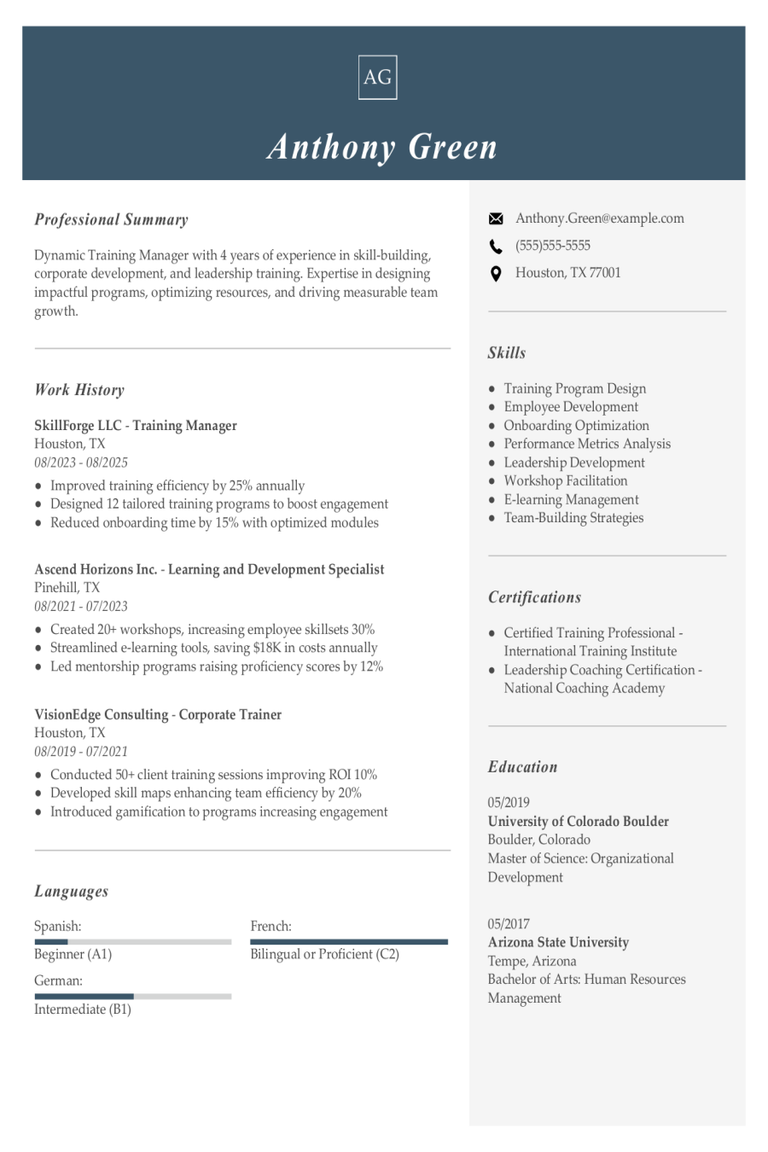
Training Manager Resume Examples & Templates for 2025
Discover how training managers showcase their skills in leading workshops and improving employee performance on their resumes. Our examples and tips will help you craft a resume that stands out
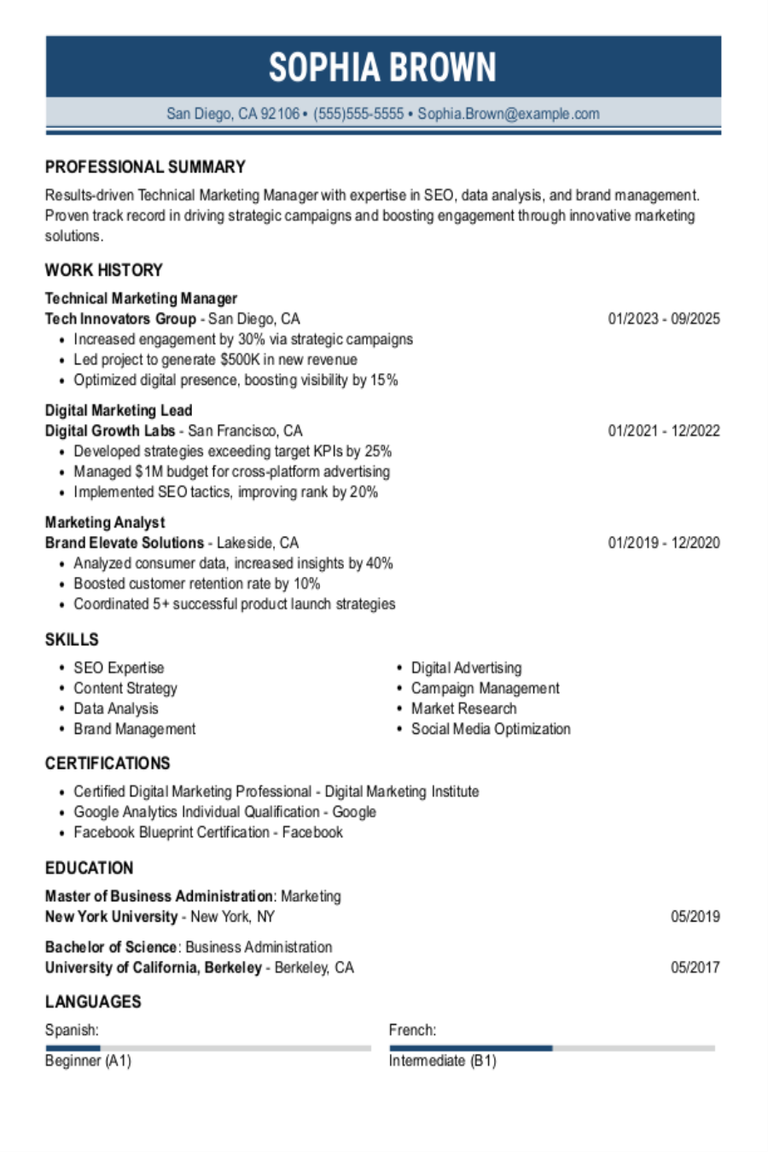
Technical Marketing Manager Resume Examples & Templates for 2025
Discover how to craft a technical marketing manager resume that shines. Learn to highlight your tech-savvy skills, marketing strategies, and project successes effectively.Build my resumeImport existing resumeCustomize this templateWhy this
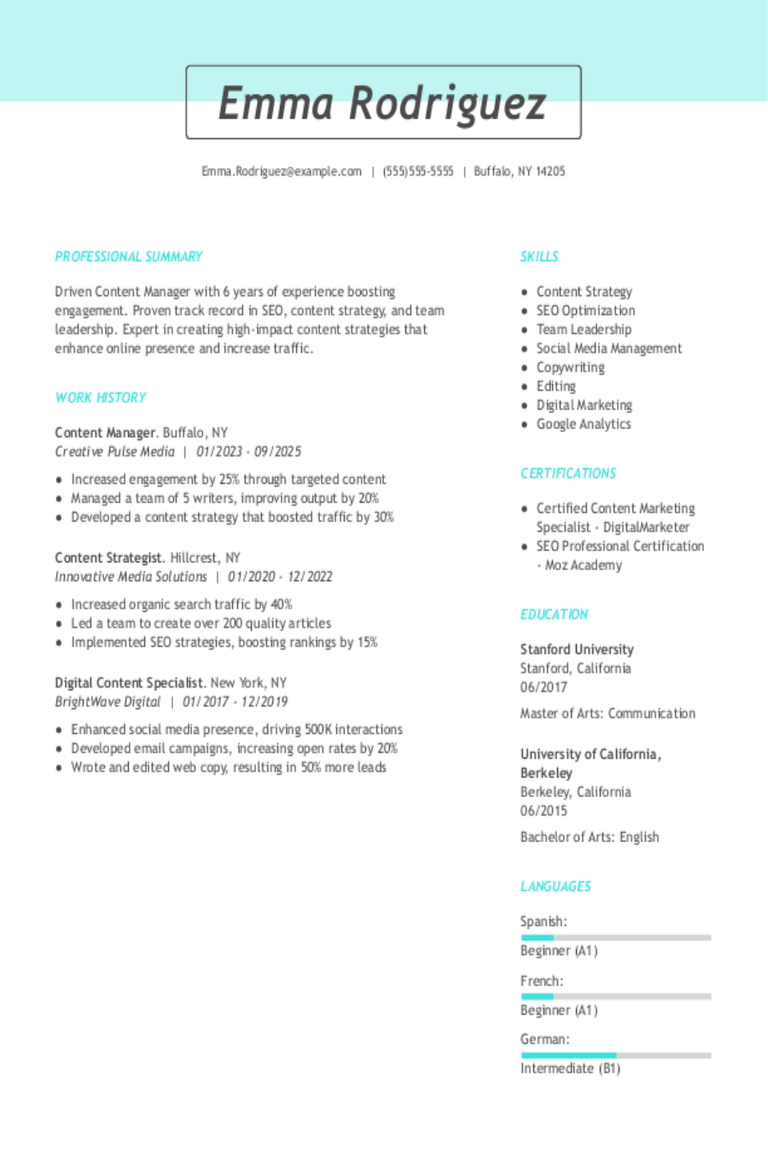
Content Manager Resume Examples & Templates for 2025
Browse content manager resume examples to see how to highlight your experience organizing, creating, and sharing engaging materials across platforms. These examples and tips help you showcase creativity, leadership, and
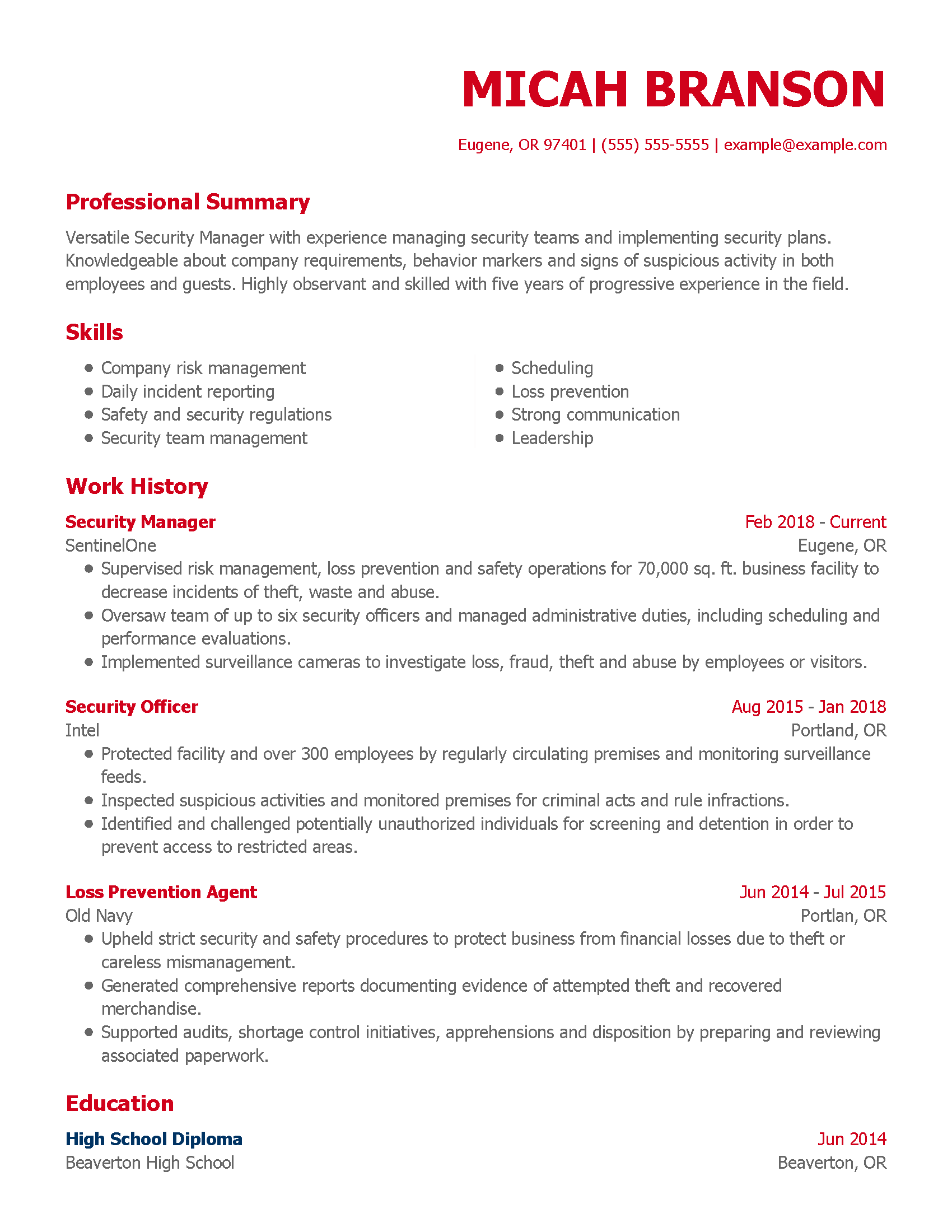
Security Manager Resume Examples & Templates for 2025
Explore security manager resume examples that showcase leadership, emergency response, and risk management. Get tips to highlight your skills and experience in keeping people and property safe.Build my resumeImport existing
